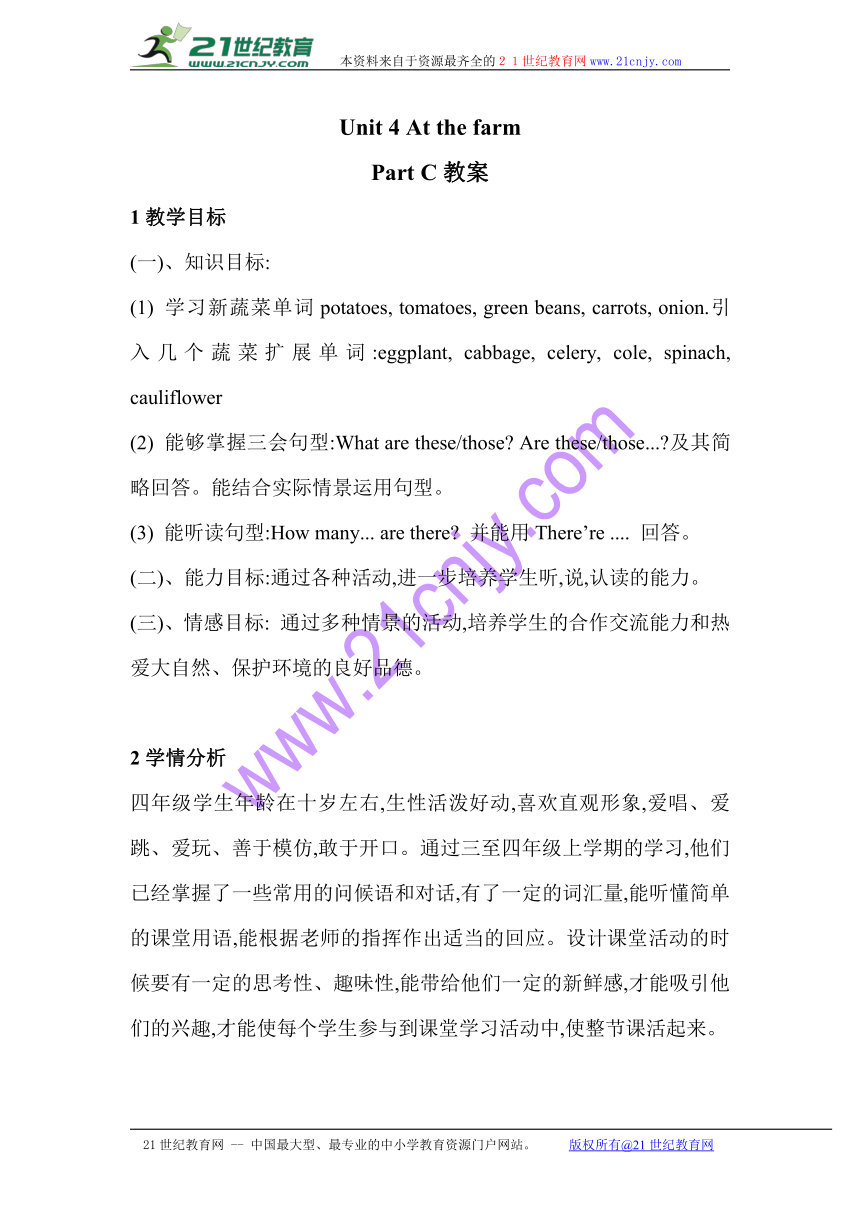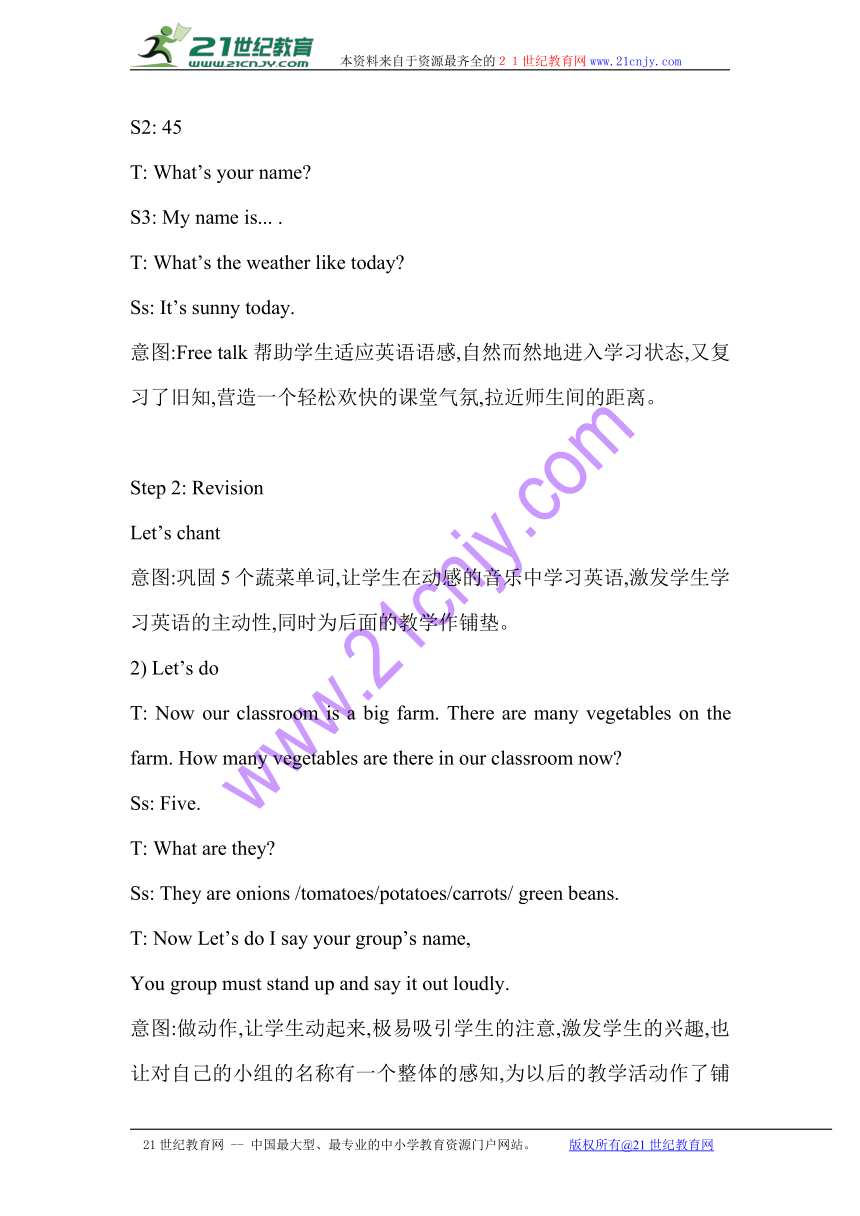Unit 4 At the farm PC 教案
文档属性
| 名称 | Unit 4 At the farm PC 教案 |

|
|
| 格式 | zip | ||
| 文件大小 | 120.4KB | ||
| 资源类型 | 教案 | ||
| 版本资源 | 人教版(PEP) | ||
| 科目 | 英语 | ||
| 更新时间 | 2016-12-30 18:51:36 | ||
图片预览




文档简介
本资料来自于资源最齐全的21世纪教育网www.21cnjy.com
Unit
4
At
the
farm
Part
C教案
1教学目标
(一)、知识目标:
(1)
学习新蔬菜单词potatoes,
tomatoes,
green
beans,
carrots,
onion.引入几个蔬菜扩展单词:eggplant,
cabbage,
celery,
cole,
spinach,
cauliflower21世纪教育网版权所有
(2)
能够掌握三会句型:What
are
these/those
Are
these/those... 及其简略回答。能结合实际情景运用句型。21教育网
(3)
能听读句型:How
many...
are
there
并能用There’re
....
回答。
(二)、能力目标:通过各种活动,进一步培养学生听,说,认读的能力。
(三)、情感目标:
通过多种情景的活动,培养学生的合作交流能力和热爱大自然、保护环境的良好品德。
2学情分析
四年级学生年龄在十岁左右,生性活泼好动,喜欢直观形象,爱唱、爱跳、爱玩、善于模仿,敢于开口。通过三至四年级上学期的学习,他们已经掌握了一些常用的问候语和对话,有了一定的词汇量,能听懂简单的课堂用语,能根据老师的指挥作出适当的回应。设计课堂活动的时候要有一定的思考性、趣味性,能带给他们一定的新鲜感,才能吸引他们的兴趣,才能使每个学生参与到课堂学习活动中,使整节课活起来。
3重点难点
本课教学内容为PEP小学英语四年级下册Unit4
At
a
Farm
A
Let’s
learn,
Let’s
chant,
Let’s
spell.它以farm
为单元主题,本课时所学内容是我们日常生活所吃的蔬菜。主要语言结构为:What
are
these /What
are
those
/Are
these/those...
Yes,
they
are./No,
they
aren’t.以及相关单词及其单词的复数形式:potatoes,
tomatoes,
green
beans,
carrots,
onions.
通过本节课的学习,学生基本能用:What
are
these/those
They’re....
Are
they...
Yes,
they
are
./
No,
they
aren’t.等句型询问复数。为下一个课时B
Let’s
talk的学习作铺垫。2·1·c·n·j·y
在教学内容的处理上,为了更好地贯穿整节课,本节内容增加了句型:“What’s
this
/that
It’s
a/an...
;
How
many... ”要求学生能用运用句型询问实物和数量,拓展学生的语言综合运用能力。
4教学过程
Sept
1:Warm-up
Free
talk
T:
How
are
you
today
Ss:
We’re
fine,
thanks.
And
you
T:
I’m
fine,
too.
Thank
you.
T:
How
old
are
you,
S1
S1:
I’m
13.
T:
How
many
students
are
there
in
your
class
S2:
45
T:
What’s
your
name
S3:
My
name
is...
.
T:
What’s
the
weather
like
today
Ss:
It’s
sunny
today.
意图:Free
talk帮助学生适应英语语感,自然而然地进入学习状态,又复习了旧知,营造一个轻松欢快的课堂气氛,拉近师生间的距离。
Step
2:
Revision
Let’s
chant
意图:巩固5个蔬菜单词,让学生在动感的音乐中学习英语,激发学生学习英语的主动性,同时为后面的教学作铺垫。21·世纪
教育网
2)
Let’s
do
T:
Now
our
classroom
is
a
big
farm.
There
are
many
vegetables
on
the
farm.
How
many
vegetables
are
there
in
our
classroom
now
Ss:
Five.
T:
What
are
they
Ss:
They
are
onions
/tomatoes/potatoes/carrots/
green
beans.
T:
Now
Let’s
do
I
say
your
group’s
name,
You
group
must
stand
up
and
say
it
out
loudly.
意图:做动作,让学生动起来,极易吸引学生的注意,激发学生的兴趣,也让对自己的小组的名称有一个整体的感知,为以后的教学活动作了铺垫。www-2-1-cnjy-com
3)
谜语
教师说谜语,引导学生用Are
they… 来猜猜是什么蔬菜。
They
are
red.
They
look
like
apples,
but
they
aren’t
apples.
What
are
they
They
are
tender
and
green.
What
are
they
They
are
long
and
orange.
Rabbits
like
eating
them.
What
are
they
They
are
round,
pink
and
white.
What
are
they
They
are
brown.
French
fries
are
made
of
them.
What
are
they
学生猜对了,教师回答Yes,
they
are.并拿出相应的单词卡片请学生拼读;如果猜错了,教师回答No,
they
aren’t.
再请其他人猜,
直到猜对为止。2-1-c-n-j-y
教师和学生聊一聊每个人喜爱的蔬菜或动物。从而引入几个蔬菜新单词:
eggplant,
cabbage,
celery,
cauliflower让学生认识。
I
like.…
Do
you
like
…
教师进行对学生进行环境保护的教育。
意图:对
5个蔬菜单词作进一步的了解,并认识更多的蔬菜单词,扩展了学生的词汇量。
Step
3:
presentation
(1)教学these,
those
利用“Vegetable
Farm”这一情景,教师将自己带来的蔬菜分别放在各个组桌面上,
然后教师走到Group
Tomato同学们中间,指着这一组的同学说。同时教师做走近走远的动作。www.21-cn-jy.com
T:
These
are
potatoes.
Ss:
These
are
potatoes.
T:
Those
are
tomatoes.
Ss:
Those
are
tomatoes.
T:
These
are
potatoes.
Those
are
tomatoes.
Ss:
These
are
tomatoes
.Those
are
potatoes.
意图:利用课堂情景
直观教学语言知识,简单明了,有助于学生理解和掌握,增加学习的趣味性。
(2)教授Are
these
/those..
Yes,
they
are.
/No,
they
aren’t.教师打开自制课件,请学生看一遍顾客和服务员的问答。然后提问:顾客为什么要用Are
those
cucumbers 问,而不用Are
these
cucumbers 问,两者有什么区别 教师根据学生的理解情况适当讲Are
those
…的用法。
教师走远Group
Tomato指着Group
Tomato蔬菜,用Are
those
... 随意说一种蔬菜名,然后点击,启发学生根据看到的用Yes,
they
are.
/
No,
they
aren’t.回答。教师进行板书。21cnjy.com
教师打开自制课件,操练
Are
those/these..
Yes,
they
are.
No,
they
aren’t.然后点击印证,先让全班一起回答,然后个人回答。
Let’s
chant
Are
these
desks
Are
these
desks
(配上相应的动作,学生双手拍桌子)
Yes,
they
are.
Yes,
they
are.
Are
those
fans
Are
those
fans
(学生用手指着课室天花板上的风扇.)
Yes,
they
are.
Yes,
they
are.
Are
these
fans
Are
these
fans
(配上相应的动作,学生双手拍桌子)
No,
they
aren’t.
No,
they
aren’t.
Are
those
desks
Are
those
desks
(学生用手指着课室天花板上的风扇.)21·cn·jy·com
No,
they
aren’t.
No,
they
aren’t.
意图:采用Chant
的形式巩固所学句型,既起到巩固的作用,又营造出轻松愉快的英语课堂气氛。
(3)教学What
are
these/those
教师再次走近各蔬菜组如走近Group
Tomato
T:
What
are
these
Ss
:引导学生用They
are
…回答。教师进行板书。
走近Group
Carrot
(引导Group
Tomato的学生问What
are
these
S1:
They
are
carrots.
走远Group
Carrot
T:
What
are
those
Ss:
They
are
carrots.
Play
a
game
传蔬菜卡游戏
(游戏说明:
听音乐传蔬菜卡,
音乐一停,
拿到蔬菜卡的同学便起来用本节课学的句型Are
these/those...
What
are
these/those
并由该学生点另一名学生起来按蔬菜卡上的内容回答.21
cnjy
com
意图:利用情景学习新句型,并用游戏巩固句型。让学生乐于、积极主动地参与体验过程,并在活动中感知、体验、感受成功,提高语言的实际运用能力。【来源:21cnj
y.co
m】
Step
4:
Let’s
talk:
1)播放录音2遍。
第一遍,只听音明白课文的内容。
第二遍,学生听录音,后跟读、模仿。
2)找一成绩好的学生和教师一起扮演对话,使用“Vegetable
Farm”
教室情景表演Let’s
talk的内容(教师做相应的动作让学生明白课文大意)。【出处:21教育名师】
意图:通过听录音,训练学生的听力,利用情景表演课文,集中学生的注意力,让学生对课文有更好理解,培养学生自主学习的能力。
Step
5:Practice
(1)Group
work
四人组成一组,每人出一张单词卡(背面示人)可组织对话如下:
S1:
What
are
these
S2:
Are
these
cgreen
beans
S3:
Yes,
they
are./No,
they
aren’t.
S1:
Look
.They
are
green
beans.
(2)
新龟兔赛跑游戏
意图:通过游戏等形式,活跃课堂,培养学生的参与意识,让学生在“动”中学。调动学生的积极性,巩固所学的知识。【来源:21·世纪·教育·网】
Step
6:
Consolidation
(1)故事(I
am
a
farmer)表演
Mr
Cat
要去参观一个农场,你是农场的主人,请你给Mr
Cat
介绍自己的农场。
(2)在课室的各蔬菜组的学生自由组合准备,教师巡视并提供学生所需要的帮助
(3)学生表演.
(4)由全体学生投票选出哪一组是“最佳搭档”赢得贴纸.
意图:通过故事形式,将知识融入玩乐之中。巩固所学知识,培养学生的竞争意识及团体合作精神,同时也培养学生的综合能力和创造力。
21世纪教育网
--
中国最大型、最专业的中小学教育资源门户网站。
版权所有@21世纪教育网
Unit
4
At
the
farm
Part
C教案
1教学目标
(一)、知识目标:
(1)
学习新蔬菜单词potatoes,
tomatoes,
green
beans,
carrots,
onion.引入几个蔬菜扩展单词:eggplant,
cabbage,
celery,
cole,
spinach,
cauliflower21世纪教育网版权所有
(2)
能够掌握三会句型:What
are
these/those
Are
these/those... 及其简略回答。能结合实际情景运用句型。21教育网
(3)
能听读句型:How
many...
are
there
并能用There’re
....
回答。
(二)、能力目标:通过各种活动,进一步培养学生听,说,认读的能力。
(三)、情感目标:
通过多种情景的活动,培养学生的合作交流能力和热爱大自然、保护环境的良好品德。
2学情分析
四年级学生年龄在十岁左右,生性活泼好动,喜欢直观形象,爱唱、爱跳、爱玩、善于模仿,敢于开口。通过三至四年级上学期的学习,他们已经掌握了一些常用的问候语和对话,有了一定的词汇量,能听懂简单的课堂用语,能根据老师的指挥作出适当的回应。设计课堂活动的时候要有一定的思考性、趣味性,能带给他们一定的新鲜感,才能吸引他们的兴趣,才能使每个学生参与到课堂学习活动中,使整节课活起来。
3重点难点
本课教学内容为PEP小学英语四年级下册Unit4
At
a
Farm
A
Let’s
learn,
Let’s
chant,
Let’s
spell.它以farm
为单元主题,本课时所学内容是我们日常生活所吃的蔬菜。主要语言结构为:What
are
these /What
are
those
/Are
these/those...
Yes,
they
are./No,
they
aren’t.以及相关单词及其单词的复数形式:potatoes,
tomatoes,
green
beans,
carrots,
onions.
通过本节课的学习,学生基本能用:What
are
these/those
They’re....
Are
they...
Yes,
they
are
./
No,
they
aren’t.等句型询问复数。为下一个课时B
Let’s
talk的学习作铺垫。2·1·c·n·j·y
在教学内容的处理上,为了更好地贯穿整节课,本节内容增加了句型:“What’s
this
/that
It’s
a/an...
;
How
many... ”要求学生能用运用句型询问实物和数量,拓展学生的语言综合运用能力。
4教学过程
Sept
1:Warm-up
Free
talk
T:
How
are
you
today
Ss:
We’re
fine,
thanks.
And
you
T:
I’m
fine,
too.
Thank
you.
T:
How
old
are
you,
S1
S1:
I’m
13.
T:
How
many
students
are
there
in
your
class
S2:
45
T:
What’s
your
name
S3:
My
name
is...
.
T:
What’s
the
weather
like
today
Ss:
It’s
sunny
today.
意图:Free
talk帮助学生适应英语语感,自然而然地进入学习状态,又复习了旧知,营造一个轻松欢快的课堂气氛,拉近师生间的距离。
Step
2:
Revision
Let’s
chant
意图:巩固5个蔬菜单词,让学生在动感的音乐中学习英语,激发学生学习英语的主动性,同时为后面的教学作铺垫。21·世纪
教育网
2)
Let’s
do
T:
Now
our
classroom
is
a
big
farm.
There
are
many
vegetables
on
the
farm.
How
many
vegetables
are
there
in
our
classroom
now
Ss:
Five.
T:
What
are
they
Ss:
They
are
onions
/tomatoes/potatoes/carrots/
green
beans.
T:
Now
Let’s
do
I
say
your
group’s
name,
You
group
must
stand
up
and
say
it
out
loudly.
意图:做动作,让学生动起来,极易吸引学生的注意,激发学生的兴趣,也让对自己的小组的名称有一个整体的感知,为以后的教学活动作了铺垫。www-2-1-cnjy-com
3)
谜语
教师说谜语,引导学生用Are
they… 来猜猜是什么蔬菜。
They
are
red.
They
look
like
apples,
but
they
aren’t
apples.
What
are
they
They
are
tender
and
green.
What
are
they
They
are
long
and
orange.
Rabbits
like
eating
them.
What
are
they
They
are
round,
pink
and
white.
What
are
they
They
are
brown.
French
fries
are
made
of
them.
What
are
they
学生猜对了,教师回答Yes,
they
are.并拿出相应的单词卡片请学生拼读;如果猜错了,教师回答No,
they
aren’t.
再请其他人猜,
直到猜对为止。2-1-c-n-j-y
教师和学生聊一聊每个人喜爱的蔬菜或动物。从而引入几个蔬菜新单词:
eggplant,
cabbage,
celery,
cauliflower让学生认识。
I
like.…
Do
you
like
…
教师进行对学生进行环境保护的教育。
意图:对
5个蔬菜单词作进一步的了解,并认识更多的蔬菜单词,扩展了学生的词汇量。
Step
3:
presentation
(1)教学these,
those
利用“Vegetable
Farm”这一情景,教师将自己带来的蔬菜分别放在各个组桌面上,
然后教师走到Group
Tomato同学们中间,指着这一组的同学说。同时教师做走近走远的动作。www.21-cn-jy.com
T:
These
are
potatoes.
Ss:
These
are
potatoes.
T:
Those
are
tomatoes.
Ss:
Those
are
tomatoes.
T:
These
are
potatoes.
Those
are
tomatoes.
Ss:
These
are
tomatoes
.Those
are
potatoes.
意图:利用课堂情景
直观教学语言知识,简单明了,有助于学生理解和掌握,增加学习的趣味性。
(2)教授Are
these
/those..
Yes,
they
are.
/No,
they
aren’t.教师打开自制课件,请学生看一遍顾客和服务员的问答。然后提问:顾客为什么要用Are
those
cucumbers 问,而不用Are
these
cucumbers 问,两者有什么区别 教师根据学生的理解情况适当讲Are
those
…的用法。
教师走远Group
Tomato指着Group
Tomato蔬菜,用Are
those
... 随意说一种蔬菜名,然后点击,启发学生根据看到的用Yes,
they
are.
/
No,
they
aren’t.回答。教师进行板书。21cnjy.com
教师打开自制课件,操练
Are
those/these..
Yes,
they
are.
No,
they
aren’t.然后点击印证,先让全班一起回答,然后个人回答。
Let’s
chant
Are
these
desks
Are
these
desks
(配上相应的动作,学生双手拍桌子)
Yes,
they
are.
Yes,
they
are.
Are
those
fans
Are
those
fans
(学生用手指着课室天花板上的风扇.)
Yes,
they
are.
Yes,
they
are.
Are
these
fans
Are
these
fans
(配上相应的动作,学生双手拍桌子)
No,
they
aren’t.
No,
they
aren’t.
Are
those
desks
Are
those
desks
(学生用手指着课室天花板上的风扇.)21·cn·jy·com
No,
they
aren’t.
No,
they
aren’t.
意图:采用Chant
的形式巩固所学句型,既起到巩固的作用,又营造出轻松愉快的英语课堂气氛。
(3)教学What
are
these/those
教师再次走近各蔬菜组如走近Group
Tomato
T:
What
are
these
Ss
:引导学生用They
are
…回答。教师进行板书。
走近Group
Carrot
(引导Group
Tomato的学生问What
are
these
S1:
They
are
carrots.
走远Group
Carrot
T:
What
are
those
Ss:
They
are
carrots.
Play
a
game
传蔬菜卡游戏
(游戏说明:
听音乐传蔬菜卡,
音乐一停,
拿到蔬菜卡的同学便起来用本节课学的句型Are
these/those...
What
are
these/those
并由该学生点另一名学生起来按蔬菜卡上的内容回答.21
cnjy
com
意图:利用情景学习新句型,并用游戏巩固句型。让学生乐于、积极主动地参与体验过程,并在活动中感知、体验、感受成功,提高语言的实际运用能力。【来源:21cnj
y.co
m】
Step
4:
Let’s
talk:
1)播放录音2遍。
第一遍,只听音明白课文的内容。
第二遍,学生听录音,后跟读、模仿。
2)找一成绩好的学生和教师一起扮演对话,使用“Vegetable
Farm”
教室情景表演Let’s
talk的内容(教师做相应的动作让学生明白课文大意)。【出处:21教育名师】
意图:通过听录音,训练学生的听力,利用情景表演课文,集中学生的注意力,让学生对课文有更好理解,培养学生自主学习的能力。
Step
5:Practice
(1)Group
work
四人组成一组,每人出一张单词卡(背面示人)可组织对话如下:
S1:
What
are
these
S2:
Are
these
cgreen
beans
S3:
Yes,
they
are./No,
they
aren’t.
S1:
Look
.They
are
green
beans.
(2)
新龟兔赛跑游戏
意图:通过游戏等形式,活跃课堂,培养学生的参与意识,让学生在“动”中学。调动学生的积极性,巩固所学的知识。【来源:21·世纪·教育·网】
Step
6:
Consolidation
(1)故事(I
am
a
farmer)表演
Mr
Cat
要去参观一个农场,你是农场的主人,请你给Mr
Cat
介绍自己的农场。
(2)在课室的各蔬菜组的学生自由组合准备,教师巡视并提供学生所需要的帮助
(3)学生表演.
(4)由全体学生投票选出哪一组是“最佳搭档”赢得贴纸.
意图:通过故事形式,将知识融入玩乐之中。巩固所学知识,培养学生的竞争意识及团体合作精神,同时也培养学生的综合能力和创造力。
21世纪教育网
--
中国最大型、最专业的中小学教育资源门户网站。
版权所有@21世纪教育网
